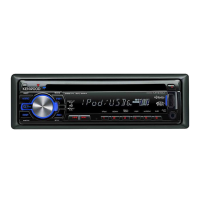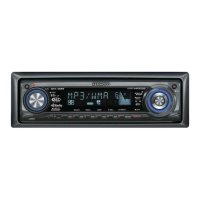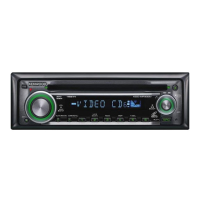Do you have a question about the Kenwood KDC-MP345U and is the answer not in the manual?
Key precautions to prevent injury or fire, including avoiding metallic objects inside the unit.
Instructions for cleaning the faceplate and caring for unit/faceplate terminals to prevent damage.
Guidelines for handling CDs, including what not to do, and a list of CDs that cannot be used.
Procedure to disable the default demonstration mode for first-time use of the unit.
Step-by-step guide to set the hour and minute for the unit's clock display.
Explanation of basic controls like power on/off, source selection, volume adjustment, and display scrolling.
Instructions for inserting discs and connecting USB/iPod devices for automatic playback.
How to select folders, songs, and fast-forward/reverse audio files or tracks.
Using buttons to pause/play music and eject discs or USB devices safely.
Switching between FM/AM bands and selecting radio stations using specific buttons.
Recalling memorized stations and how to store stations into memory buttons.
Instructions on how to detach the front faceplate of the unit for security purposes.
How the audio system mutes automatically during incoming phone calls and resumes afterward.
Explanation of various indicators on the display, such as ATT, ST, EQ, B.BOOST, and IN.
Guide to changing the displayed information for different sources like Tuner, CD, and Audio files.
Steps to enter, select, and set various functions using the unit's controls.
Configuration options for clock adjustment, display brightness, and text display scrolling.
Settings for radio seek mode, automatic station memory, and monaural reception.
Controls for Bass Boost, System Q equalizer, Bass/Middle/Treble levels, Balance, Fader, and Subwoofer.
Options for managing iPod playlists, setting AUX source names, and enabling/disabling demonstration mode.
Setting the skip search ratio for music and deleting songs from the iPod playlist.
Enabling/disabling key beep sounds and configuring the AUX input source selection.
Settings for how the unit reads CDs and switching preout between rear and subwoofer outputs.
Optimizing sound based on speaker type and instructions for upgrading unit firmware.
Adjusting subwoofer phase and setting the Low Pass Filter for the subwoofer output.
Adjusting source volume differences and enabling Supreme technology for enhanced audio.
Functions to repeat tracks/files, play music randomly, or scan through tracks/files.
How to search for specific music tracks or files from the connected media source.
Detailed steps for searching for songs on an iPod using the Music Search function.
Using characters to search for songs on the iPod by their names.
Process for registering favorite songs into the unit's playlist and deleting songs.
Enabling/disabling direct iPod operation using the iPod itself instead of the unit.
Using the remote control to search for music by entering the track number.
Buttons for selecting music, folders, and controlling playback for iPod/CD/Audio files.
Buttons for band selection, station tuning, and recalling preset radio stations.
Buttons for overall unit control such as volume, source selection, and exiting modes.
Instructions for replacing the battery in the remote control unit.
Lists playable audio file formats (MP3, WMA) and disc media types (CD-R/RW/ROM).
Details on compatible USB devices and specific iPod/iPhone models supported by the unit.
Information on connecting USB devices, including recommended cables and limitations.
Details on the PC application for managing music files and its compatibility with the unit.
Important safety warnings, FCC regulations, and California perchlorate warning.
Visual identification and description of the accessories provided with the unit.
Comprehensive guide for installing the unit in a vehicle, including wiring and mounting steps.
Diagram and explanation of how to connect the main wiring harness to speakers and power sources.
Details on connecting power control, mute control wires, and antenna input.
Procedure for removing the outer frame, often a preliminary step for installation or removal.
Step-by-step instructions for securely installing or removing the main unit from the vehicle console.
Addresses problems like inability to set up subwoofer, low pass filter, or no subwoofer output.
Solutions for poor radio reception, discs not playing, or dirty/scratched CDs.
Troubleshooting sound skipping during audio playback or issues with volume adjustment.
Explanation of error messages related to CD reading, disc unreadability, and general unit malfunctions.
Troubleshooting unsupported USB devices, iPod connection failures, and USB removal mode.
Detailed technical data for the FM/AM tuner and CD player sections, including frequency ranges and sensitivities.
Specifications for USB interface, audio output, auxiliary input, and general unit dimensions/power.
Defines the warranty period, coverage for defects, and exclusions for products purchased through military exchanges.
Outlines the buyer's duties, such as retaining proof of purchase and making the unit available for service.
A listing of Kenwood authorized service centers in various international locations.
| Model | KDC-MP345U |
|---|---|
| DIN Size | Single DIN |
| Tuner | AM/FM |
| CD Playback | Yes |
| MP3 Playback | Yes |
| WMA Playback | Yes |
| USB Input | Yes |
| Aux Input | Yes |
| Bluetooth | No |
| Display Type | LCD |
| Detachable Face | Yes |
| CEA-2006 Compliant | Yes |
| Sub Preamp Outputs | Yes |
| iPod Compatibility | Yes |
| HD Radio | No |
| Satellite Radio Ready | No |
| Memory Card Reader | No |
| Remote Control | Yes |
| Preset EQ | Yes |
| Subwoofer Output | Yes |
| RMS Power Bandwidth | 20 Hz to 20 kHz |
| Preamp Outputs | 2-channel |
| Power Output | 50 Watts x 4 |
| RMS Power Output | 22 Watts x 4 |
| Preamp Voltage | 2.5 Volts |












